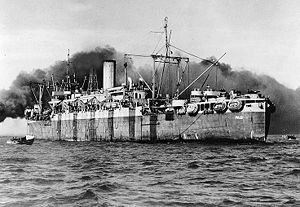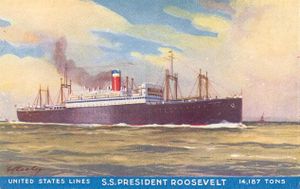USS Joseph T. Dickman (APA-13)
 USS Joseph T. Dickman (APA-13) in the process of disembarking troops, circa 1943 | |
| Career (United States) | 100x35px |
|---|---|
| Name: | USS Joseph T. Dickman (APA-13) |
| Namesake: | US Army General Joseph T. Dickman |
| Builder: | New York Shipbuilding |
| Launched: | 6 July 1921 |
| Christened: | Peninsula State |
| Completed: | January 1922 |
| Acquired: | (by the Navy) 27 May 1941 |
| Commissioned: | (As AP-26) 10 June 1941 |
| Decommissioned: | 7 March 1946 |
| Renamed: | President Pierce, President Roosevelt, USS Joseph T. Dickman |
| Reclassified: | AP-26 to APA-13, 1 February 1943 |
| Struck: | 12 April 1946 |
| Honours and awards: | Six battle stars for World War II service |
| Fate: | Sold for scrap, 9 January 1948 |
| General characteristics | |
| Class and type: | Harris-class attack transport |
| Displacement: | 13,529 tons (lt), 21,900 t.(fl) |
| Length: | 535 ft 2 in |
| Beam: | 72 ft 4 in |
| Draft: | 31 ft 3 in |
| Propulsion: |
2 x Bethlehem Steel Curtis type turbines, 8 x Yarrow header-type boilers, 2 propellers, designed shaft horsepower 10,000. |
| Speed: | 17 knots |
| Capacity: |
Troops: 95 Officers, 1,961 Enlisted Cargo: 170,000 cu ft, 2,600 tons |
| Complement: | Officers 58, Enlisted 635 |
| Armament: | 4 x 3"/50 caliber dual-purpose gun mounts, 2 x twin 40mm gun mounts, 18 x single 20mm gun mounts. |
USS Joseph T. Dickman (APA-13) was a Harris-class attack transport that served with the US Navy during World War II.
Early career
Joseph T. Dickman was built as Peninsula State for the United States Shipping Board by the New York Shipbuilding Corporation of Camden, New Jersey, in 1921 and 1922. She began transatlantic service for United States Lines in 1922, and soon afterward in May was renamed President Pierce. In August 1922 the ship was renamed President Roosevelt, a name she carried during her many years of passenger service.
In January 1926, President Roosevelt was involved in the rescue of the crew of the British cargo ship ship SS Antinoe that foundered in the Atlantic Ocean in January 1926. George Fried, the the Roosevelt's captain, was given a ticker-tape parade in Manhattan in honor of his heroism.
Military career
Taken over by the War Department in October 1940, she was named Joseph T. Dickman and converted to a troopship by Atlantic Basin Iron Works of Brooklyn. The ship was subsequently transferred to the Navy 27 May 1941 and further converted to Navy use at New York Navy Yard. She commissioned at the Navy Yard (as AP-26) on 10 June 1941, Lt. Comdr. Charles W. Harwood, USCG, in command.
The new transport got underway 26 June 1941 for Hampton Roads, and until August she took part in amphibious training exercises off Onslow Beach, N.C. After these important landings, which helped develop the tactics and equipment to be used later with such great success, Joseph T. Dickman returned to New York 14 August. She then moved to Boston for further conversion, remaining there until 1 October.
Stores were loaded at Norfolk, Virginia in October, after which the transport proceeded to Halifax to load British troops. With five other troop ships she departed 10 November 1941 on the long voyage to India. While the ship carried these British reinforcements, the Japanese attack on Pearl Harbor brought the United States into the war 7 December 1941.
Joseph T. Dickman arrived Bombay via Trinidad and Cape Town 27 December 1941 and debarked troops. Departing 10 January, she retraced her steps to New York, arriving 28 February 1942 for the installation of new boats and lowering equipment. After leaving the yard in April the ship underwent tests in Hampton Roads before departing 11 May for transport duties in the Caribbean. She stopped at San Juan and Bermuda to debark troops before returning to Norfolk 27 May 1942.
Joseph T. Dickman carried further reinforcements to Caribbean bases in June, and spent July on amphibious exercises in Chesapeake Bay. Training and additional conversion to increase her boat capacity continued into October, when the ship prepared for Operation Torch, the invasion of North Africa. As part of the Western Naval Task Force, Joseph T. Dickman got underway from Norfolk 24 October to take part in the first amphibious invasion ever launched across an entire ocean. Arriving in the transport area of Fedhala early 8 November, she began the debarkation. She remained off shore until German submarine attacks forced her seaward 12 November.
As the successful invasion was consolidated, however, Joseph T. Dickman entered Casablanca harbor 15 November and completed unloading. Two days later she was underway for Norfolk, arriving 30 November 1942.
After embarking troops and taking on cargo, Joseph T. Dickman departed 27 December 1942 for the Pacific via the Panama Canal. She stopped at Nouméa and Brisbane before sailing for Norfolk again, where she arrived 10 March 1943. During this voyage, on 1 February 1943, the ship was reclassified APA-13.
The veteran troopship departed 10 May 1943 for North Africa, in preparation for the invasion of Sicily. She arrived Mers el Kebir 23 May and, after landing rehearsals, got underway with the invasion fleet from Algiers 6 July. As a part of Rear Admiral Hall's Gela landing force, she arrived off the beaches 10 July and began the long process of debarkation. Next day she suffered minor damage fighting off German bombing attacks, damaging at least three of the attackers with her accurate gunfire. With the invasion quickly successful, the ship was underway for Algiers 12 July for more exercises.
The next major amphibious operation in the campaign to regain Italy was slated for Salerno; and, after training, Joseph T. Dickman arrived off the beaches with Hall's Southern Attack Force 9 September. Rockets from an LCS attached to the ship helped clear the way for the first wave of boats, and, after receiving near misses from shore batteries, the transport debarked her troops and returned to Mers el Kebir.
As the battle to consolidate the beachhead began, Joseph T. Dickman returned with reinforcements to Salerno 6 October. She made two other follow-up voyages from Africa to Italy, the final one with over 1,000 French troops. The ship sailed 30 November 1943 for Norfolk by way of Scotland. Upon her arrival 1 January 1944, the ship underwent battle repairs; and, after embarking troops, sailed 11 February 1944 for Glasgow. During the next few months the ship was engaged in intensive training for the giant Normandy invasion, scheduled for June.
Sailing from England 5 June, she arrived off Utah Beach early the next day and landed her troops without a mishap. On the afternoon of D-Day, she steamed to Portland with casualties, later making a shuttle voyage to the beaches 14 June as troops moved inland to liberate France. Upon arriving Mers el Kebir 10 July 1944, Joseph T. Dickman began preparations for still another landing, this time in southern France.
After exacting training operations, she sailed from Sicily 13 August 1944, arriving off the Delta Force beaches next day to debark her troops. After smooth and skillful unloading, she steamed to Naples, arriving 17 August. In the weeks that followed, Joseph T. Dickman made five follow-up voyages to southern France from Mediterranean staging points as the Allies pressed northward. The veteran ship sailed from Mers el Kebir 25 October for the United States, arriving Boston 8 November.
Joseph T. Dickman, after taking part in every major amphibious operation in the European-African theater. Now turned her attention to the Pacific.
Pacific War
She sailed 24 January 1945 with troops for Guadalcanal, arriving via Espiritu Santo 12 February. There she began training operations for the invasion of Okinawa. From 21-27 March the transports made final preparations at Ulithi, sailing the latter date for the last and greatest of the Pacific invasions. The troops stormed ashore 1 April, but the transport remained off the beaches helping to ward off air attacks while unloading cargo until 9 April. She then sailed to Saipan, and continued to Pearl Harbor, where she anchored 25 April 1945.
Joseph T. Dickman arrived at San Francisco with veterans 30 May. After two troop voyages to Pearl Harbor, the ship remained at the Navy Yard there for conversion to a casualty evacuation ship for the projected invasion of Japan. Emerging 10 August, she was en route to San Francisco when the fighting ended 14 August 1945.
Joseph T. Dickman then sailed for the Philippines 24 August; and, upon arrival in Manila 17 September, took on American and Allied soldiers who had been prisoners of the Japanese for transportation to the United States. Coincidentally, four British enlisted men came on board, who after 3½ years in a prison camp were returning to the United States on the same ship which had carried them from Halifax to Bombay in 1941.
The ship reached San Francisco 16 October. Assigned to Operation Magic-Carpet, Joseph T. Dickman made a voyage to Pearl Harbor, returning to Seattle 2 December 1945. She moved south to San Francisco 13 January 1946. The ship steamed to Suisun Bay in March, decommissioned 7 March, and was returned to the Maritime Commission 22 January 1947, who transferred her to the National Defense Reserve Fleet, Suisun Bay, Benicia, California. She was sold on 9 January 1948 to the Kaiser Co. for scrapping. Joseph T. Dickman received six battle stars for World War II service.
References
- USS Joseph T. Dickman (APA-13), DANFS Online
- APA-13 Joseph T. Dickman, Navsource Online
This article includes text from the public domain Dictionary of American Naval Fighting Ships.
External links
- Marine Exchange page about the rescue of the crew of Antinoe
- [1] images of the SS President Roosevelt
| ||||||||
| ||||||||
- Pages with broken file links
- Wikipedia articles incorporating text from the Dictionary of American Naval Fighting Ships
- Design 1029 ships
- Ships built in New Jersey
- 1921 ships
- Design 1029 ships of the United States Army
- Harris class attack transports
- World War II auxiliary ships of the United States
- World War II amphibious warfare vessels of the United States

